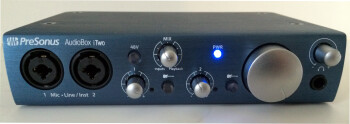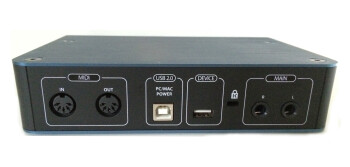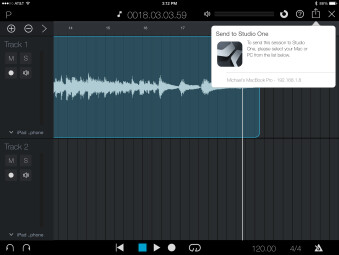More and more audio interfaces are hitting the market that are capable of connecting directly to an iOS device or a computer. PreSonus recently released two such units, the AudioBox iTwo and AudioBox iOne. We’ll focus here on the iTwo, a 2x2 interface sporting two mic preamps.
Small, blue and versatile
The tabletop style AudioBox iTwo is housed in the blue-colored chassis familiar from previous AudioBox interfaces. The unit is small and light, checking in at 7.6” (W) X 5.3” (D) X 1.7” (H) and weighing a scant 1.35 lbs. It supports up to 24-bit, 96 kHz audio on both Mac/PC and iOS.
The front panel sports two XLR/1/4” combo jacks that can handle mic, line or instrument inputs. When connecting an instrument, you press the channel’s Instrument button, which has a little guitar icon over it. A global 48V phantom power switch is the other front-panel button, and like the instrument button, it lights up when activated. Also on the front panel is a 1/4” headphone jack, located on the lower right hand side.
Knob-wise, you get in input level control for each channel, and there’s a global Mix control for varying between source audio and that from your computer or device, which allows you to monitor without latency. The front panel also contains a large master output gain knob, and headphone level knob.
The back panel includes MIDI In and Out jacks, 1/4” Main left and right outputs, a USB port, and the Device port, for connecting your iPad, iPhone, or iPod touch.
If you’re using the box with a computer, you connect the included USB Type B cable from the interface’s USB port to that of your computer. In this configuration, the AudioBox iTwo is powered by your computer’s USB bus.
If you’re connecting to an iOS device, you plug your dock connector cable from your device into the Device jack. When you do, you won’t see the AudioBox iTwo power up, because it’s not bus powered from your iOS device. You have to connect the USB cable from the unit to your iOS device’s charging block to get power. So even though this unit is iOS friendly, it’s not a true mobile interface, for iOS at least, because you need AC to use it with your iOS device.
No matter if you’re connecting to to an iOS device or to your computer, any MIDI device you connect will need to be self powered, there’s no bus powering like with USB MIDI interfaces.
Using the iTwo
Now that we’ve looked at the features, let’s talk about the AudioBox iTwo in action. I was able to set it up easily with both my iPad Air and my MacBook Pro. Operation is straightforward and generally quite intuitive.
The one feature that might be confusing to some is the Mix control. Turn it fully left and you hear only the audio coming through the input. Turn it completely to the right and you hear only the output coming from your computer or iOS device. Settings less extreme get a combination of the two, with their signal levels in proportion to where the knob is positioned. The idea is to be able to hear your direct signal while recording, to avoid latency.
If you need more information, download the Owner’s Manual from the PreSonus site. The “Hook Up Guide, ” which comes in the box, offers the barest minimum of information. The PDF manual, on the other hand, is detailed and well written.
For iOS recording, PreSonus offers Capture Duo, a free two-channel recording app (available on the the iOS App Store), and Studio One Artist, a mid-level version of PreSonus’s Studio One Mac/PC DAW, which normally sells for $99. Once you register the hardware with PreSonus, Studio One Artist appears in your user area on the PreSonus web site. You can record on the iOS app, and then transfer the files wirelessly to Studio One. The process is incredibly easy, and more efficient than other iPad export methods I’ve tried.
Of course, you can also use the AudioBox iTwo for recording into other Core Audio iOS apps. I also tested the interface with WaveMachineLabs Auria DAW, and it worked perfectly.
I found the mic preamps to be pretty good for a unit in this price range. I compared them with my FMR Audio 8380 preamp on both acoustic guitar and spoken voice, and while the PreSonus preamp wasn’t as rich sounding as the more expensive FMR, it held up pretty well, and is certainly quite useable. For critical tracking you can always connect an external mic pre if you want.
Here are the comparisons. All were recorded with a Mojave Audio MA300 tube mic:
Acoustic guitar into AudioBox iTwo preamp.

Acoustic guitar into FMR Audio RNP 8380 preamp, output to AudioBox iTwo line input.

Spoken voice into AudioBox iTwo preamp.


Interface with me
The PreSonus AudioBox iTwo ($159.95) provides a good value in a compact tabletop interface that can be used for both computer and iOS recording and production. Everything works as advertised, the sound quality is better than you’d expect in this price range, and you get some nice free software. The AudioBox iTwo costs $30 more than the iOne, but you get two mic preamps instead of one, and the Mix control, which to me, makes it worth the relatively small extra cost. (PreSonus also offers the iTwo Studio, $259.95, a bundle that adds a mic, headphones, and a free Nimbit account, to the interface and Studio One Artist software.)
My only complaint about the AudioBox iTwo is that it requires AC power when running in iOS mode, and when using an external MIDI controller, which makes it less mobile friendly than some other interfaces. But overall, PreSonus has yet another impressive product to add to its already large list.



